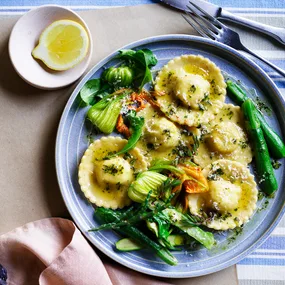Tortellini is one of Italian cuisine’s most recognisable dishes. It’s emblematic of the Emilia-Romagna region, but like most classic dishes, its origins are disputed – Bologna and Modena each claim the dish as their own.
References to the pasta’s distinctive pointed hat shape date back as far as 1570, although the name didn’t enter the vernacular until sometime late in the 17th century, and there’s been heated debate ever since about what constitutes true tortellini. In 1974, in an attempt to codify the dish, the Accademia Italiana della Cucina, Bologna section, and the Confraternita del Tortellino registered with the Bologna Chamber of Commerce a recipe deeming pork loin, prosciutto crudo, Bolognese mortadella, Parmigiano-Reggiano, eggs and nutmeg in specific proportions to be the true filling.
For many centuries, the tortellini were served in brodo – preferably a capon broth – but these days it’s commonly seen with cream or with butter and parmesan, as we’ve prepared it here.
Purists say a tortellino must have a pointed top, and according to Caz Hildebrand and Jacob Kenedy in The Geometry of Pasta, the pasta is “more elegant” when made from squares than from circles. Contrarily, we’ve opted for circles, but if you prefer to take the purist approach, cut the pasta dough into squares instead of circles in step three. Place a little filling in the centre, then fold the pasta to enclose it and form a triangle. Wind the bottom edge of the triangle around your fingertip, press the points together to seal and presto – a hat-shaped tortellino.
The myth surrounding the shape of tortellini is compelling: the pasta is said to have been inspired by a belly button spied through a key-hole. Said belly button has been variously accredited to the goddess Venus, or the Renaissance femme fatale Lucrezia Borgia. The eye doing the spying through the keyhole belonged, in both cases, to a peeping innkeeper. What that says about Italian men, we’re not sure, but it certainly gives fresh meaning to the term navel-gazing.










